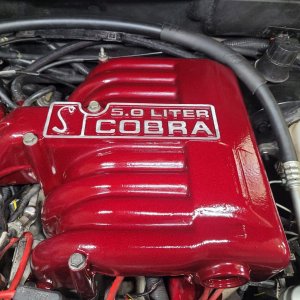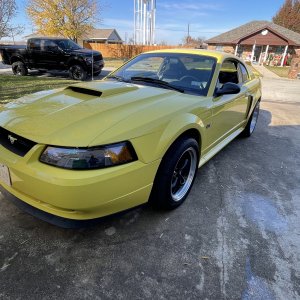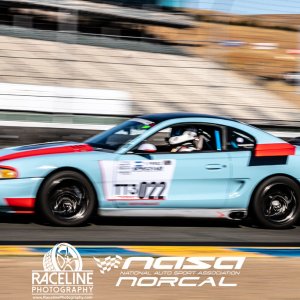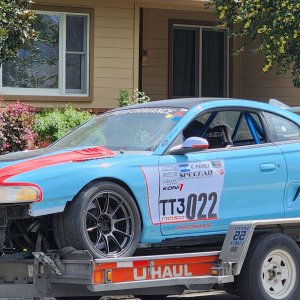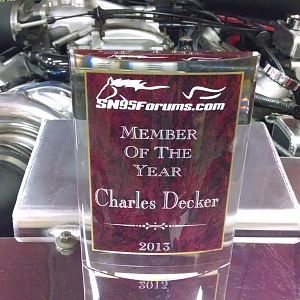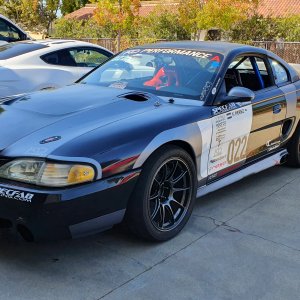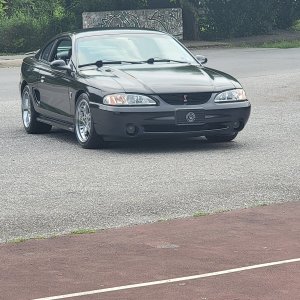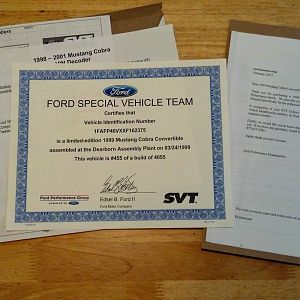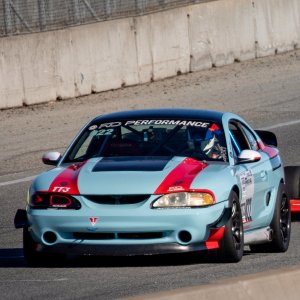Dry
In a dry nitrous system, extra fuel required is introduced through the fuel injectors, keeping the manifold dry of fuel. This property is what gives the dry system its name. Fuel flow can be increased either by increasing the pressure in the fuel injection system, or by modifying the vehicle's computer to increase the time the fuel injectors remain open during the engine cycle. This is typically done by spraying nitrous past the mass airflow sensor (MAF), which then sends a signal to the vehicle's computer telling it that it sees colder denser air, and that more fuel is needed. This is typically not an exact method of adding fuel. Once additional fuel has been introduced, it can burn with the extra oxygen provided by the nitrous, providing additional power.
Dry nitrous systems rely on a single type nozzle that only sprays nitrous through it, not nitrous and fuel. These nitrous nozzles generally spray in a 90 degree pattern.
Wet single-point
A wet single-point nitrous system introduces the fuel and nitrous together, causing the upper intake manifold to become wet with fuel. In carbureted applications, this is typically accomplished with a spraybar plate mounted between the carburetor base and the intake manifold, while cars fitted with electronic fuel injection often use a plate mounted between the manifold and the base of the throttle body, or a single nozzle mounted in the intake tract. However, most makes of nitrous systems combined with unsuitable intake designs, often result in distribution problems and/or intake backfires. Dry-flow intakes are designed to contain only air, which will travel through smaller pipes and tighter turns with less pressure, whereas wet-flow intakes are designed to contain a mixture of fuel and air. Wet nitrous systems tend to produce more power than dry systems, but in some cases can be more expensive and difficult to install.
A wet nozzle differs in the way that it takes in both nitrous and fuel which are metered by jets to create a perfect or proper air-fuel ratio (AFR). Proper atomisation of the fuel and nitrous will ensure consistent power gains.
Newer wet nitrous kits on domestic[clarification needed] cars have become increasingly easy to install by pulling fuel via the schrader valve on the fuel rail, which is normally designated as a fuel test port. It makes plumbing and using a wet nitrous kit much simpler.
Wet direct port
A wet direct port nitrous system introduces nitrous and fuel directly into each intake port on the engine. These systems are also known as direct port nitrous systems. Normally, these systems combine nitrous and fuel through several nozzles similar in design to a wet single-point nozzle, which mixes and meters the nitrous and fuel delivered to each cylinder individually, allowing each cylinder's nitrous/fuel ratio to be adjusted without affecting the other cylinders. Note that there are still several ways to introduce nitrous through a direct port system. There are several different types of nozzles and placements ranging from fogger nozzles that requires one to drill and tap the manifold, to specialty direct port E.F.I. nozzles that fit into the fuel injector ports along with the fuel injectors.
A multi-point system is the most powerful type of nitrous system, due to the placement of the nozzle in each runner, as well as the ability to use more and higher capacity solenoid valves. Wet multi-point kits can go as high as 3,000 horsepower (2,400 kW) with only one stage, but most produce less than half that amount with two, three or even four stages.[citation needed] These systems are also the most complex and expensive systems, requiring significant modification to the engine, including adding distribution blocks and solenoid assemblies, as well as drilling, tapping and constructing plumbing for each cylinder runner. These systems are most often used on racing vehicles specially built to take the strain of such high power levels. Many high-horsepower race applications will use more than one nozzle per cylinder, plumbed in stages to allow greater control of how much power is delivered with each stage. A two-stage system will actually allow three different levels of additional horsepower; for example, a small first stage can be used in first gear to prevent excessive wheelspin, then turned off in favor of a larger second stage once the car is moving. In top gear, both stages can be activated at the same time for maximum horsepower. A more recent improvement on the staged concept from WON is the progressive delivery system, which allows a simpler single stage system to act even better than multiple stages, delivering a smoothly progressive increase in power which is adjustable to suit the user requirements.
Plenum bar
Another type of system is called a plenum bar system. These are spraybars that are installed inside of the plenums of the intake manifold. Plenum bar systems are usually used in conjunction with direct port systems in multi-stage nitrous systems.
In a dry nitrous system, extra fuel required is introduced through the fuel injectors, keeping the manifold dry of fuel. This property is what gives the dry system its name. Fuel flow can be increased either by increasing the pressure in the fuel injection system, or by modifying the vehicle's computer to increase the time the fuel injectors remain open during the engine cycle. This is typically done by spraying nitrous past the mass airflow sensor (MAF), which then sends a signal to the vehicle's computer telling it that it sees colder denser air, and that more fuel is needed. This is typically not an exact method of adding fuel. Once additional fuel has been introduced, it can burn with the extra oxygen provided by the nitrous, providing additional power.
Dry nitrous systems rely on a single type nozzle that only sprays nitrous through it, not nitrous and fuel. These nitrous nozzles generally spray in a 90 degree pattern.
Wet single-point
A wet single-point nitrous system introduces the fuel and nitrous together, causing the upper intake manifold to become wet with fuel. In carbureted applications, this is typically accomplished with a spraybar plate mounted between the carburetor base and the intake manifold, while cars fitted with electronic fuel injection often use a plate mounted between the manifold and the base of the throttle body, or a single nozzle mounted in the intake tract. However, most makes of nitrous systems combined with unsuitable intake designs, often result in distribution problems and/or intake backfires. Dry-flow intakes are designed to contain only air, which will travel through smaller pipes and tighter turns with less pressure, whereas wet-flow intakes are designed to contain a mixture of fuel and air. Wet nitrous systems tend to produce more power than dry systems, but in some cases can be more expensive and difficult to install.
A wet nozzle differs in the way that it takes in both nitrous and fuel which are metered by jets to create a perfect or proper air-fuel ratio (AFR). Proper atomisation of the fuel and nitrous will ensure consistent power gains.
Newer wet nitrous kits on domestic[clarification needed] cars have become increasingly easy to install by pulling fuel via the schrader valve on the fuel rail, which is normally designated as a fuel test port. It makes plumbing and using a wet nitrous kit much simpler.
Wet direct port
A wet direct port nitrous system introduces nitrous and fuel directly into each intake port on the engine. These systems are also known as direct port nitrous systems. Normally, these systems combine nitrous and fuel through several nozzles similar in design to a wet single-point nozzle, which mixes and meters the nitrous and fuel delivered to each cylinder individually, allowing each cylinder's nitrous/fuel ratio to be adjusted without affecting the other cylinders. Note that there are still several ways to introduce nitrous through a direct port system. There are several different types of nozzles and placements ranging from fogger nozzles that requires one to drill and tap the manifold, to specialty direct port E.F.I. nozzles that fit into the fuel injector ports along with the fuel injectors.
A multi-point system is the most powerful type of nitrous system, due to the placement of the nozzle in each runner, as well as the ability to use more and higher capacity solenoid valves. Wet multi-point kits can go as high as 3,000 horsepower (2,400 kW) with only one stage, but most produce less than half that amount with two, three or even four stages.[citation needed] These systems are also the most complex and expensive systems, requiring significant modification to the engine, including adding distribution blocks and solenoid assemblies, as well as drilling, tapping and constructing plumbing for each cylinder runner. These systems are most often used on racing vehicles specially built to take the strain of such high power levels. Many high-horsepower race applications will use more than one nozzle per cylinder, plumbed in stages to allow greater control of how much power is delivered with each stage. A two-stage system will actually allow three different levels of additional horsepower; for example, a small first stage can be used in first gear to prevent excessive wheelspin, then turned off in favor of a larger second stage once the car is moving. In top gear, both stages can be activated at the same time for maximum horsepower. A more recent improvement on the staged concept from WON is the progressive delivery system, which allows a simpler single stage system to act even better than multiple stages, delivering a smoothly progressive increase in power which is adjustable to suit the user requirements.
Plenum bar
Another type of system is called a plenum bar system. These are spraybars that are installed inside of the plenums of the intake manifold. Plenum bar systems are usually used in conjunction with direct port systems in multi-stage nitrous systems.

